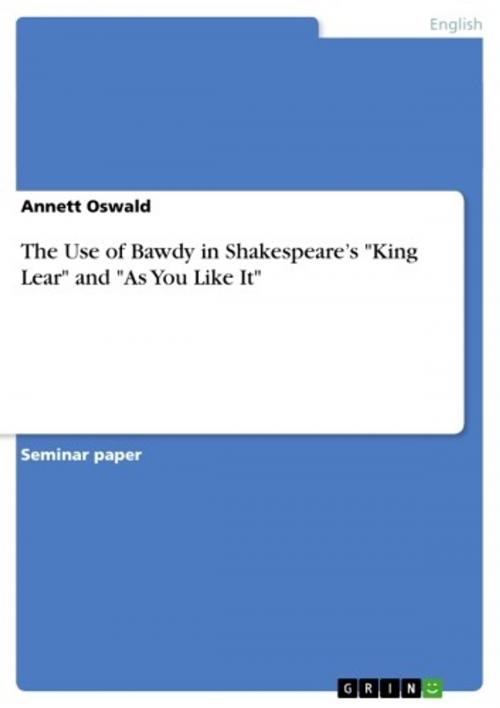The Use of Bawdy in Shakespeare's 'King Lear' and 'As You Like It'
Fiction & Literature, Literary Theory & Criticism, British| Author: | Annett Oswald | ISBN: | 9783638737814 |
| Publisher: | GRIN Verlag | Publication: | May 29, 2007 |
| Imprint: | GRIN Verlag | Language: | English |
| Author: | Annett Oswald |
| ISBN: | 9783638737814 |
| Publisher: | GRIN Verlag |
| Publication: | May 29, 2007 |
| Imprint: | GRIN Verlag |
| Language: | English |
Seminar paper from the year 2005 in the subject English Language and Literature Studies - Literature, grade: 2,2, Martin Luther University (Institut für Anglistik und Amerikanistik), course: Shakespeare at the Crossroads between Philology and Linguistics, 11 entries in the bibliography, language: English, abstract: William Shakespeare (1564-1616) used many different meanings and connotations of a single word and a whole range of words appropriate for describing certain subjects to create bawdy puns and allusions on sexual issues in his dramas. It is the concern of this essay to examine the subject of 'bawdiness' more closely and to work out, why, how and through whom Shakespeare made use of bawdy puns. These results may give some insights into Shakespeare's thoughts about gender roles, his relationship to sexuality in general and how he thought about the Elizabethan audience's reaction towards his strong sexual treatment. The first two parts of this essay will provide a short survey of the Early Modern English of the common people in 1600 and will later on particularly examine Shakespeare's use of witty and insulting language. Part four will present a table with 'bawdy' examples out of the two plays of Shakespeare, 'King Lear' and 'As you like it' with particular attention to the position when and by whom the pun is uttered. Grounding on the examples, the third part of section four will make a comparison between the uses of bawdy in tragedies and comedies and will work out differences, similarities and the profound line of reasoning behind it. The closing part of this essay, part five, offers some main conclusions and thoughts about the topic of 'bawdiness' in 'King Lear' and 'As you like it'.
Seminar paper from the year 2005 in the subject English Language and Literature Studies - Literature, grade: 2,2, Martin Luther University (Institut für Anglistik und Amerikanistik), course: Shakespeare at the Crossroads between Philology and Linguistics, 11 entries in the bibliography, language: English, abstract: William Shakespeare (1564-1616) used many different meanings and connotations of a single word and a whole range of words appropriate for describing certain subjects to create bawdy puns and allusions on sexual issues in his dramas. It is the concern of this essay to examine the subject of 'bawdiness' more closely and to work out, why, how and through whom Shakespeare made use of bawdy puns. These results may give some insights into Shakespeare's thoughts about gender roles, his relationship to sexuality in general and how he thought about the Elizabethan audience's reaction towards his strong sexual treatment. The first two parts of this essay will provide a short survey of the Early Modern English of the common people in 1600 and will later on particularly examine Shakespeare's use of witty and insulting language. Part four will present a table with 'bawdy' examples out of the two plays of Shakespeare, 'King Lear' and 'As you like it' with particular attention to the position when and by whom the pun is uttered. Grounding on the examples, the third part of section four will make a comparison between the uses of bawdy in tragedies and comedies and will work out differences, similarities and the profound line of reasoning behind it. The closing part of this essay, part five, offers some main conclusions and thoughts about the topic of 'bawdiness' in 'King Lear' and 'As you like it'.















